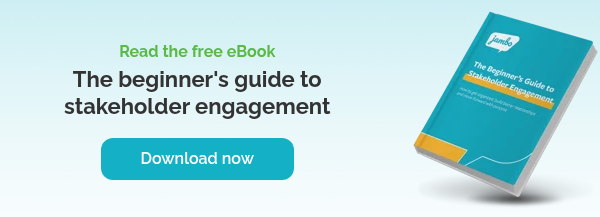
Whether you're focused on stakeholder engagement, risk management, meeting regulatory requirements, or developing positive stakeholder relationships, trust is vital. We’ve compiled this detailed list to help you learn how to build trust.
Siete formas de generar confianza entre las partes interesadas
1. Investigue a sus interlocutores
Building stakeholder trust starts with researching your stakeholders so you have a strong foundation of information to ensure your interactions with them are sincere. This is important because by coming to your engagement sessions having researched them, you can show your stakeholders you've taken the time to learn about them, are invested in them and are willing to listen.
2. Seek to understand your stakeholder's history with engagement
The more you seek to understand your stakeholders and their unique perspectives, the more you'll be able to engage in more relevant and meaningful ways for everyone. You need to find out if they have an earlier history with your organization and, if possible, if they have ever been involved in an engagement process like yours.
Hay que entender cuándo se ha roto la confianza en el pasado
You may identify places where trust has been broken in the past, either by your organization, a similar organization, or a similar process. You'll want to understand those pain points affecting your stakeholders and be mindful that those negative past experiences will need to be accounted for and considered.
You're building trust and relationships on behalf of your organization
Remember, it is not just about building a relationship for the duration of this one project. You’re building trust for years to come, so you need to seek to understand your stakeholders’ history with your organization, as it can impact your ability to build trusting relationships now and in the future.
3. Ask questions to learn what's important to your stakeholders
You'll inevitably need to ask some questions when researching and working to understand your stakeholders' engagement history. If there's a history, it's worthwhile to ask your internal team(s) about your stakeholders, as this can provide some crucial insights into what your stakeholders might care about and how they may already feel about your organization.
Beyond asking your team(s), ask your stakeholders for information about what's important to them. By asking your stakeholders for their perspectives instead of making assumptions, you'll help show them that you care about what's important to them, which will go a long way towards building trust.
4. Sea honesto sobre lo que sus interlocutores pueden esperar de usted
From the start, be honest and open with your stakeholders about what they can expect from you and this entire process (and let them know if anything changes). Stakeholders don't want to enter a process and expect to have a say in whether a project moves forward, only to discover that the project has already been decided, and they don't have a say.
Aprender del espectro de la participación pública del IAP2
In the Spectrum of Public Participation developed by the International Association for Public Participation (IAP2), there are five levels of participation (i.e., inform, consult, involve, collaborate, and empower). To help build trust, you'll want to clarify where your engagement with stakeholders lies on that spectrum from the start. Don't tell somebody that they're going to be able to directly inform the "yes or no" decisions of a project if they're actually at the "inform-level" and not the "empower-level."
Recuerde que sus interlocutores han dedicado tiempo a participar en la conversación y el proceso, así que respete su tiempo siendo sincero sobre lo que pueden esperar y lo que hará con la información y los comentarios que compartan con usted.
5. Cumpla todos sus compromisos y promesas con las partes interesadas
An important way to build trust is by following through on every commitment or promise to your stakeholders. For example, if you've agreed to email a stakeholder once a month or send them a document after a meeting, then follow through accordingly. In trusting relationships, it's not enough to say you'll do something; your words and actions must be consistent.
Pro-tip for following through on stakeholder commitments: Following through doesn't just help build trust; it's also a crucial stakeholder engagement risk management tool. To ensure you never miss a commitment, you need to be aware of every promise made to your stakeholders and have the means to track their progress. Stakeholder Relationship Management (SRM) software can help you stay on top of your stakeholder commitments.
6. Reconozca y comunique a sus interlocutores cuando cometa un error
How you communicate with your stakeholders during and after a mistake can affect your project's level of risk and how much your stakeholders trust your organization moving forward. So, what do you do when you make a mistake?
If you happen to forget about a commitment or if something goes wrong, be honest with your stakeholders, be ready to acknowledge the mistake, and apologize if necessary. By owning up to any mistakes, you're showing your commitment to your stakeholder relationships and showing your dedication to making things right.
Once your stakeholders see your willingness to do better and remedy your mistakes, they'll likely see your commitment to honesty and transparency, which are key pillars to trusting relationships. This honesty and transparency (that we don't always see from all organizations) can strengthen trust over time and help mitigate any risks that arose from the mistake.
Don't try to hide mistakes
It's essential to acknowledge your mistakes and not play them off as "nothing" or blame them on someone else. Stakeholders will know if you're trying to hide something from them, so you're much better off being honest and explaining what has happened immediately.
Cuando comunique un error, comente los hechos
When you communicate with a stakeholder about a mistake, lead with the facts, and give them time, space, and opportunities to communicate how they feel about the situation. While this isn't always easy, keep communication channels open and navigate this with support from leadership in your organization so that everyone is working together in an aligned, factual, and honest manner.
Learn how to manage and improve stakeholder relationships with proven frameworks and tools→
7. Sea proactivo en sus relaciones con las partes interesadas
Cuando describimos a alguien como proactivo, a menudo es alguien con quien podemos contar para "hacer las cosas". Ser proactivo en la implicación de las partes interesadas significa que éstas pueden contar contigo para que asumas la responsabilidad de lo que ocurre en tu(s) proyecto(s) y busques las mejores soluciones posibles de forma productiva y honesta.
La gente apoyará lo que ayude a crear y construir, así que las partes interesadas no deben sentirse quemadas por tus decisiones y acciones. Necesitarán honestidad y transparencia continuas sobre lo que pueden esperar de ti, del proceso y del proyecto para generar confianza. Necesitarán saber dónde están sus oportunidades de influir y entender que se lo comunicarás a medida que ocurran las cosas, que mantendrás tu palabra y que harás las cosas bien si hay algún error en el camino.
Generar confianza entre las partes interesadas requiere esfuerzo, tiempo y compromiso.
Todo lo que hemos compartido hoy aquí requerirá un compromiso por tu parte, pero la confianza que ganarás a cambio bien merece el tiempo y el esfuerzo que invertirás.
Principales conclusiones
|
Next steps: Beginner's guide to stakeholder engagement
For those new to stakeholder engagement and seeking more information, check out our Beginner's Guide to Stakeholder Engagement. This 27-page eBook helps you learn how to get organized, build better relationships, and move forward purposefully.








